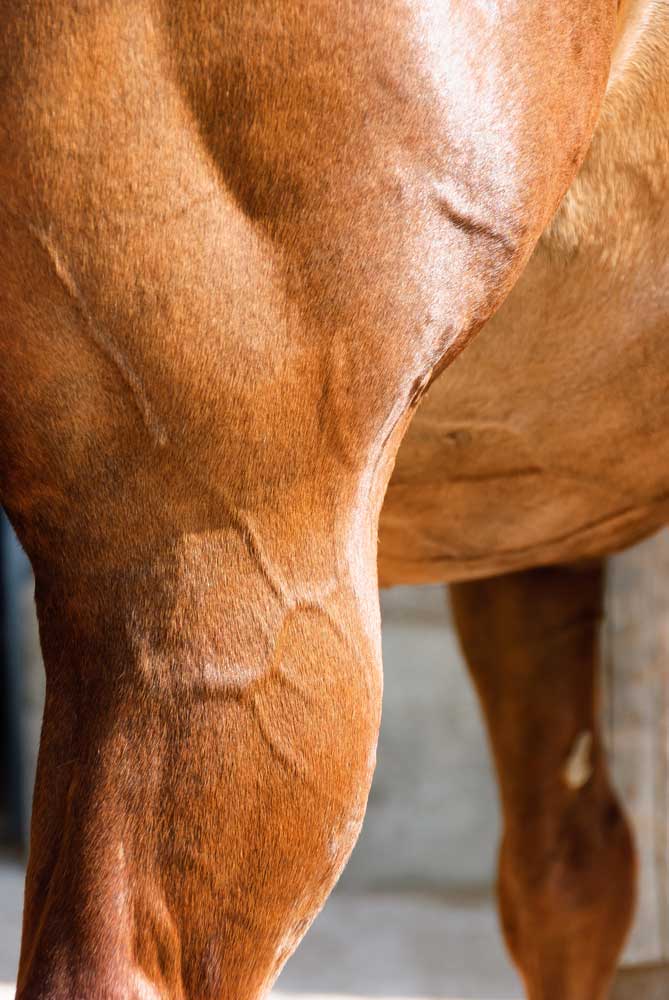Thanks to heavy coverage in horse industry media, tying-up and EPSM have become almost synonymous. But there are many possible causes of equine muscle issues, and identifying the right one is critical to effective treatment.
Full blown tying-up is easy to spot, but many horses that experience mild to moderate muscle cramping and impaired performance (e.g. poor effort at the end of a race, reluctance to collect) can be suspected of having a mild version of tying-up. Muscle enzymes may be elevated, but not strikingly. This huge category includes horses with muscle stiffness, spasm, possible twitching, and suspected performance or gait-related issues. These horses are not lame, but their gaits are not free-flowing and may be short and choppy, especially in the hindquarters. They are less than enthusiastic about working, may have poor endurance and are often irritable, nervous or depressed. These horses are sore all over, their appetite is often off, and they’re not progressing with training. Before even assuming this is a primary muscle problem, it’s important to rule out lameness – bone or joint issues. The feet in particular should be carefully scrutinized, if not nerve blocked, to be sure.
Causes and Testing
A chemistry screen should be done to rule out electrolyte problems and check muscle enzyme levels. Sodium deficiency/dehydration and inadequate magnesium intake are common and can cause these symptoms. Hard water can contain enough calcium to throw off the calcium:magnesium ratio in the diet, with ionized calcium in water having a much greater effect than you might predict from the amount taken in. If the water is hard and there are muscular problems, consider adding an extra 5 to 10 grams of magnesium.
Inadequate vitamin E and selenium intake can also be contributing factors. Both these can be checked by blood tests to make sure the levels are sufficient. A 500 kg horse in work should receive at least 2,000 IU/day of vitamin E and 2 mg of selenium, unless you’re in an area where forage selenium is adequate. Selenium yeast is the preferred form.
Tying-Up or Other Muscular Problems?
A related issue is muscle loss or failure to build muscle normally with training. This is most common in young horses but can occur at any age. The horse will have lackluster progression in training but may or may not also show obvious cramping or twitching. Inadequate total protein in general is often the cause, because young horses in training are commonly fed as adults when their protein requirements are actually much higher to meet growth and training adaptation. Supplementation with branched chain amino acids (leucine, isoleucine, valine) or leucine alone can be particularly helpful as these are in high concentration in muscle.
Even more obvious tying-up symptoms do not necessarily indicate EPSM. Tying-up is a symptom, not a specific disorder. It refers to painful muscle cramping that begins while the horse is exercising. The hindquarters are the most dramatically affected since they do the most work, but other muscle groups will be also be firmer than normal. The gait becomes progressively stiffer and more wooden until the horse essentially “seizes up” and refuses to move at all.
Hallmarks of tying-up that distinguish it from other muscular problems like HYPP include onset during exercise and actual muscle damage (rhabdomyolysis), demonstrated by increased muscle enzymes in the blood. In severe cases, a red-brown discoloration of the urine is caused by muscle pigment (myoglobin).
Management Keys
A systematic checklist can help you sort through all the possible causes and contributing factors of a onetime tyingup episode:
• Do not miss exercise days.
• As much turnout or hand-walking as possible in addition to formal exercise.
• Ensure adequate salt intake – 1 oz/ day in cool weather, up to 3 oz/day in hot weather, and a balanced sweat replacement electrolyte supplement if worked over 2 hours/day.
• Diet based on free choice hay, feeding grain only as needed to maintain body condition. Back off grain on days not worked
. • Selenium 1 mg/500 lbs body weight and vitamin E 1,000 IU/500 lbs body weight daily for active horses. For horses with symptoms of poor muscle mass, cramping, poor performance:
• Ensure protein intake is 1.8 to 2 grams/ kg of body weight daily in the total diet.
• 10 to 20 grams of L-leucine or a mix of L-leucine, L-isoleucine and L-valine/day to support muscle.
• L-carnitine, 10 grams/day, to assist adaptation to training.
Horses that continue to have issues despite these measures may have a genetically determined predisposition and may also require other measures.
Sporadic vs. Recurrent Tying-Up
Tying-up may be sporadic or recurrent. Horses that have tied up on multiple occasions most likely have a genetic muscle disorder. Sporadic tying-up, on the other hand, can have many causes including overwork or electrolyte disturbances. Rhabdomyolysis can also accompany heat stroke or depletion of energy stores in the muscle.
Horses in heavy training involving speed are sometimes prone to tying-up when they are starting to perform at significant speeds. It’s unclear whether this is related to too much or too little glycogen (storage form of glucose in the muscles), fiber types changing as they adapt to the exercise, more minor damage that was not recognized before it finally comes to a head, and other possible factors. However, I personally do not automatically consider horses that tie up in an isolated episode to necessarily have an underlying genetic muscle disorder.
Eleanor Kellon, VMD, currently serves as the Staff Veterinary Specialist for Uckele Health & Nutrition. An established authority in the field of equine nutrition for over 30 years, Dr. Kellon is a valuable resource in the field of applications and nutraceuticals in horses. She formerly served as Veterinary Editor for Horse Journal and John Lyons Perfect Horse and is owner of Equine Nutritional Solutions, a thriving private practice.







